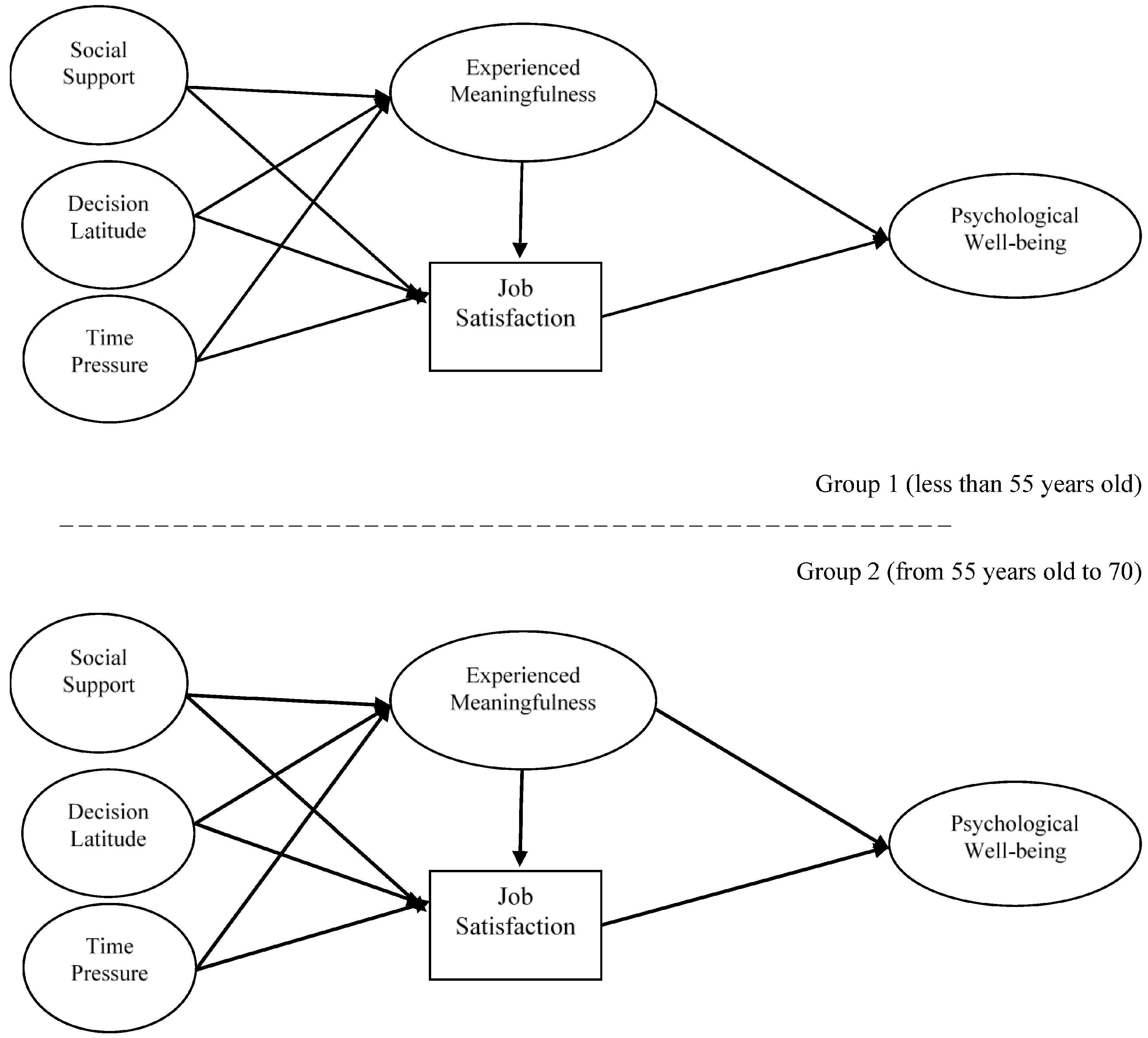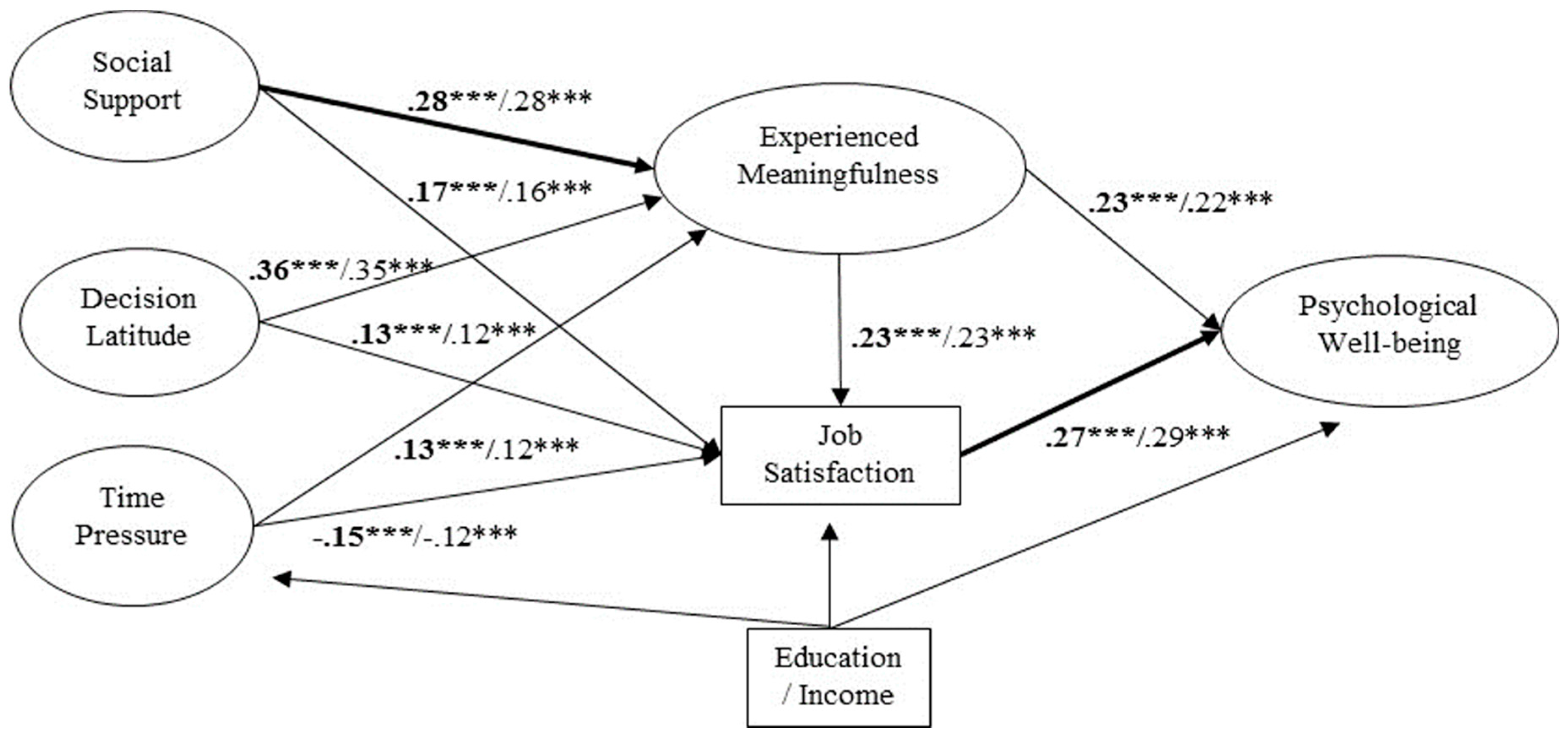How Work Characteristics Are Related to European Workers’ Psychological Well-Being. A Comparison of Two Age Groups
Abstract
:1. Introduction
2. Materials and Methods
3. Results
3.1. Descriptive and Preliminary Analyses
3.2. Hypothesis Testing
4. Discussion
5. Limitations and Future Research
6. Conclusions
Acknowledgments
Author Contributions
Conflicts of Interest
References
- European Commission. Communication from the Commission Europe 2020: A Strategy for Smart, Sustainable and Inclusive Growth. Available online: http://ec.europa.eu/eu2020/pdf/ (accessed on 2 October 2017).
- Ayala, Y.; Peiró, J.M.; Tordera, N.; Lorente, L.; Yeves, J. Job satisfaction and innovative performance in young Spanish employees: Testing new patterns in the Happy-Productive Worker Thesis. A discriminant study. J. Happiness Stud. 2016. [Google Scholar] [CrossRef]
- O’Toole, J.; Lawler, E.E. The New American Workplace; Palgrave: New York, NY, USA, 2006; ISBN 978-1-40-398491-3. [Google Scholar]
- Truxillo, D.M.; Cadiz, D.M.; Rineer, J.R.; Zaniboni, S.; Fraccaroli, F. A lifespan perspective on job design: Fitting the job and the worker to promote job satisfaction, engagement, and performance. Organ. Psychol. Rev. 2012, 2, 340–360. [Google Scholar] [CrossRef]
- Morgeson, F.P.; Campion, M.A. Work design. In Handbook of Psychology: Industrial and Organizational Psychology; Borman, W.C., Ilgen, D.R., Klimoski, R.J., Eds.; Wiley: Hoboken, NJ, USA, 2003; ISBN 978-0-470-76887-7. [Google Scholar]
- Burbonnais, R.; Comeau, M.; Vézina, M. Job strain and evolution of mental health among nurses. J. Occup. Health Psychol. 1999, 4, 95–107. [Google Scholar] [CrossRef]
- Hackman, J.R.; Oldham, G.R. Work Design; Addison Wesley: Boston, MA, USA, 1980. [Google Scholar]
- Humphrey, S.E.; Nahrgang, J.D.; Morgeson, F.P. Integrating motivational, social, and contextual work design features: A meta-analytic summary and theoretical extension of the work design literature. J. Appl. Psychol. 2007, 92, 1332–1356. [Google Scholar] [CrossRef] [PubMed]
- Spector, P.E. Job Satisfaction: Application, Assessment, Cause, and Consequence; Sage Publications: Thousand Oakes, CA, USA, 1997; ISBN 978-07-6-198923-3. [Google Scholar]
- Eurofound. Health and Well-Being at Work. A Report Based on the Vth EWCS. Available online: http://eurofound.europa.eu/health-and-well-being-at-work (accessed on 12 September 2017).
- Rechel, B.; Grundy, E.; Robine, J.M.; Cylus, J.; Mackenbach, J.P.; Knai, C.; McKee, M. Ageing in the European Union. Lancet 2013, 381, 1312–1322. [Google Scholar] [CrossRef]
- Kontis, V.; Bennett, J.E.; Mathers, C.D.; Li, G.; Foreman, K.; Ezzati, M. Future life expectancy in 35 industrialised countries: Projections with a Bayesian model ensemble. Lancet 2017, 389, 1323–1335. [Google Scholar] [CrossRef]
- Eurofound. The 2015 Ageing Report: Underlying Assumptions and Projection Methodologies. Available online: http://ec.europa.eu/economy_finance/publications/european_economy/2014/pdf/ee8_en.pdf (accessed on 29 September 2017).
- Nilsson, K. Conceptualisation of ageing in relation to factors of importance for extending working life—A review. Scand. J. Public Health 2016, 44, 490–505. [Google Scholar] [CrossRef] [PubMed]
- Peiró, J.M.; Tordera, N.; Potočnik, K. Retirement practices in different countries. In The Oxford Handbook of Retirement; Wang, M., Ed.; Oxford University Press: New York, NY, USA, 2013; ISBN 978-0-19-974652-1. [Google Scholar]
- Ng, T.W.H.; Feldman, D.C. The relationships of age with job attitudes: A meta-analysis. Pers. Psychol. 2010, 63, 677–718. [Google Scholar] [CrossRef]
- Schalk, R.; van Veldhoven, M.; de Lange, A.H.; De Witte, H.; Kraus, K.; Stamov-Roßnagel, C.; Tordera, N.; van der Heijden, B.; Zappalà, S.; Bal, M.; et al. Moving European research on work and ageing forward: Overview and agenda. Eur. J. Work Org. Psychol. 2010, 19, 76–101. [Google Scholar] [CrossRef] [Green Version]
- Kanfer, R.; Ackerman, P. Aging, adult development and work motivation. Acad. Manag. Rev. 2004, 4, 440–458. [Google Scholar] [CrossRef]
- Fifth European Working Conditions Survey. Available online: http://www.eurofound.europa.eu/surveys/ewcs/2010/ (accessed on 12 February 2016).
- Eurofound. Trends in Job Quality in Europe. Available online: https://www.eurofound.europa.eu/publications/executive-summary/2012/working-conditions/trends-in-job-quality-in-europe-executive-summary (accessed on 12 July 2017).
- Podsakoff, P.M.; Mackenzie, S.B.; Lee, J.; Podsakoff, N.P. Common Method Biases in Behavioral Research: A critical review of the literature and recommended remedies. J. Appl. Psychol 2003, 5, 879–903. [Google Scholar] [CrossRef] [PubMed]
- Paterson, T.A.; Harms, P.D.; Steel, P.; Credé, M. An assessment of the magnitude of effect sizes: Evidence from 30 years of meta-analysis in management. J. Leadersh. Organ. Stud. 2016, 23, 66–81. [Google Scholar] [CrossRef]
- Bliese, P.D. Whithin-group agreement, non-independence, and reliability. In Multilevel Theory, Research, and Methods in Organizations; Klein, K.J., Kozlowski, S.W.J., Eds.; Wiley Company: San Francisco, CA, USA, 2000; pp. 349–381. ISBN 978-0-7879-5228-0. [Google Scholar]
- Byrne, B.M. Structural equation modeling with AMOS, EQS, and LISREL: Comparative approaches to testing for the factorial validity of a measuring instrument. Int. J. Test. 2002, 1, 55–86. [Google Scholar] [CrossRef]
- Hirschi, A. Calling and Work Engagement: Moderated Mediation Model of Work Meaningfulness, Occupational Identity and Occupational Self-efficacy. J. Couns. Psychol. 2012, 3, 479–485. [Google Scholar] [CrossRef] [PubMed] [Green Version]
- European Foundation for the Improvement of Living and Working Conditions. Living Longer, Working Better: Active Ageing in Europe. Available online: http://www.eurofound.europa.eu/resourcepacks/activeageing.htm (accessed on 12 March 2016).
- Liden, R.C.; Wayne, S.J.; Sparrowe, R.T. An examination of the mediating role of psychological empowerment on the relations between the job, interpersonal relationships, and work outcomes. J. Appl. Psychol. 2000, 85, 407–416. [Google Scholar] [CrossRef] [PubMed]
- Spreitzer, G.M.; Kizilos, M.A.; Naso, S.W. A dimensional analysis of the relationship between psychological empowerment and effectiveness, satisfaction, and strain. J. Manag. 1997, 23, 679–704. [Google Scholar] [CrossRef]
- Carstensen, L.L. Evidence for a life-span theory of socioemotional selectivity. Curr. Dir. Psychol. Sci. 1995, 4, 151–156. [Google Scholar] [CrossRef]
- Zacher, H.; Jimmison, N.L.; Bordia, P. Time pressure and coworker support mediate the curvilinear relationship between age and occupational well-Being. J. Occup. Health Psychol. 2014, 19, 462–475. [Google Scholar] [CrossRef] [PubMed]
- Bless, H.; Fiedler, K. Mood and the regulation of information processing and behavior. In Hearts and Minds: Affective Influences on Social Cognition and Behaviour; Forgas, J.P., Ed.; Psychology Press: New York, NY, USA, 2006; pp. 65–84. [Google Scholar]
- Oldham, G.R.; Fried, Y. Job research design and theory: Past, present and future. Organ. Behav. Hum. Decis. Process. 2016, 136, 20–35. [Google Scholar] [CrossRef]
- Wanous, J.P.; Reichers, A.E.; Hudy, M.J. Overall job satisfaction: How good are single-item measures? J. Appl. Psychol. 1997, 82, 247–252. [Google Scholar] [CrossRef] [PubMed]
- Topa, G.; Moriano, J.A.; Moreno, A. Psychosocial determinants of financial planning for retirement among immigrants in Europe. J. Econ. Psychol. 2012, 33, 527–537. [Google Scholar] [CrossRef]
- Petrou, P.; Demerouti, E.; Xanthopoulou, D. Regular versus cutback-related change: The role of employee job crafting in organizational change contexts of different nature. Int. J. Stress Manag. 2017, 24, 62–85. [Google Scholar] [CrossRef]


| M | SD | Response Scale | 1 | 2 | 3 | 4 | 5 | 6 | |
|---|---|---|---|---|---|---|---|---|---|
| 1 Social support | 3.84 | 1.02 | 1–5 | 1 | |||||
| 2 Decision latitude | 3.06 | 1.08 | 1–5 | 0.33 ** | 1 | ||||
| 3 Time pressure | 3.57 | 1.85 | 1–7 | −0.04 ** | −0.04 ** | 1 | |||
| 4 Meaningfulness | 4.24 | 0.82 | 1–5 | 0.30 ** | 0.35 ** | −0.11 | 1 | ||
| 5 Job Satisfaction | 2.96 | 0.74 | 1–4 | 0.26 ** | 0.23 ** | −0.14 ** | 0.31 ** | 1 | |
| 6 Gen. Well-being | 4.23 | 1.06 | 1–6 | 0.23 ** | 0.19 ** | −0.04 ** | 0.28 ** | 0.36 ** | 1 |
| Model | χ2 | df | RMSEA | SRMR | AGFI | CFI | IFI | Δχ2 | Δdf |
|---|---|---|---|---|---|---|---|---|---|
| M1 | 19,322.1 | 134 | 0.062 | 0.06 | 0.92 | 0.91 | 0.91 | ||
| M2 | 18,203.6 | 135 | 0.060 | 0.06 | 0.92 | 0.92 | 0.92 | M2 − M1 = 11,218 | 1 *** |
| M3 | 19,659.2 | 136 | 0.062 | 0.07 | 0.92 | 0.91 | 0.91 | M3 − M2 = 1455.6 | 3 *** |
| M4 | 19,521.2 | 134 | 0.062 | 0.08 | 0.92 | 0.91 | 0.91 | M4 − M3 = 138 | 2 *** |
© 2018 by the authors. Licensee MDPI, Basel, Switzerland. This article is an open access article distributed under the terms and conditions of the Creative Commons Attribution (CC BY) license (http://creativecommons.org/licenses/by/4.0/).
Share and Cite
Lorente, L.; Tordera, N.; Peiró, J.M. How Work Characteristics Are Related to European Workers’ Psychological Well-Being. A Comparison of Two Age Groups. Int. J. Environ. Res. Public Health 2018, 15, 127. https://doi.org/10.3390/ijerph15010127
Lorente L, Tordera N, Peiró JM. How Work Characteristics Are Related to European Workers’ Psychological Well-Being. A Comparison of Two Age Groups. International Journal of Environmental Research and Public Health. 2018; 15(1):127. https://doi.org/10.3390/ijerph15010127
Chicago/Turabian StyleLorente, Laura, Núria Tordera, and José María Peiró. 2018. "How Work Characteristics Are Related to European Workers’ Psychological Well-Being. A Comparison of Two Age Groups" International Journal of Environmental Research and Public Health 15, no. 1: 127. https://doi.org/10.3390/ijerph15010127
APA StyleLorente, L., Tordera, N., & Peiró, J. M. (2018). How Work Characteristics Are Related to European Workers’ Psychological Well-Being. A Comparison of Two Age Groups. International Journal of Environmental Research and Public Health, 15(1), 127. https://doi.org/10.3390/ijerph15010127





